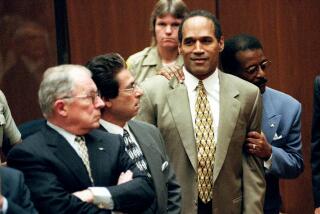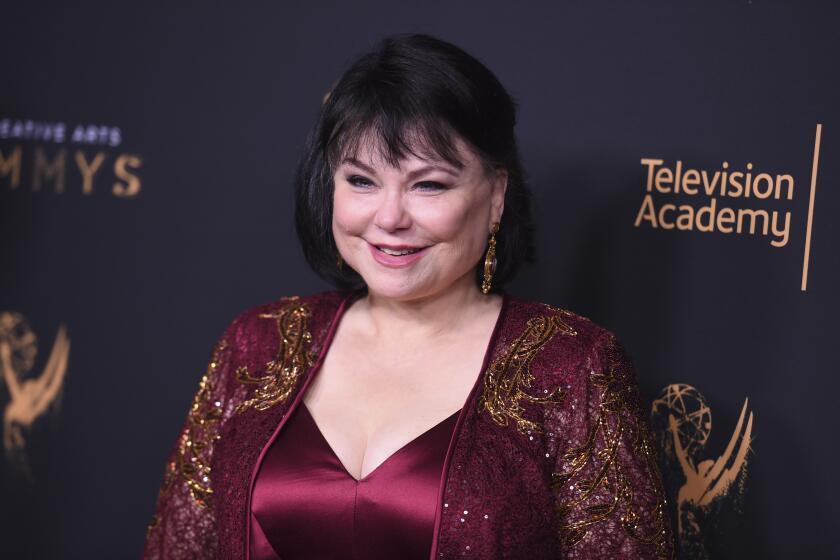‘Phil Spector,’ on trial
Are you planning to watch HBO’s “Phil Spector”? Then step into my cubicle. We need to talk.
I’m just a reporter, so my opinions about film aesthetics don’t add up to much, but as one of the only journalists to cover both of Spector’s murder trials, I can tell you that this movie, which premieres Sunday, is a bomb factually.
And in an era when millions depend on “The Daily Show” for their news and best picture nominees for their history lessons, that scares me. Most viewers will know very little about the Spector case, and when the program is over, their understanding will be deeply flawed. Except they won’t realize that.
PHOTOS: Celebrirty portraits by The Times
“Wow,” I can hear them saying as the credits roll. “I had no idea that Phil Spector was railroaded. Juries are so stupid. The entire justice system is a joke.”
Of course, filmmakers — particularly one as talented as writer-director David Mamet — are entitled to artistic license. But the problem here is that the movie blends fact and fiction into a misinformation smoothie. Characters bear the actual names of participants, dialogue is lifted directly from trial transcripts, and Al Pacino nails Spector’s shuffle and rasp. But when the movie jets off to the land of make believe — as it often does — there’s no red flashing light to warn the audience.
What’s especially galling is that the film commits the very crime it condemns. “Phil Spector” argues that a famous eccentric can’t get a fair trial because the bloodthirsty, ignorant public is willfully blind to the facts. But the movie supports its thesis by ignoring, misrepresenting and soft-pedaling the evidence.
For those of you who didn’t spend the better part of a year in a windowless courtroom with Spector, a quick refresher: On Feb. 3, 2003, Spector met a struggling actress named Lana Clarkson at the Sunset Strip club where she worked as a hostess. They repaired to his Alhambra mansion, where two hours later, she was shot in the mouth as she sat in a chair by the front door.
After he was arrested on suspicion of murder, Spector claimed Clarkson killed herself. The first jury to hear the case deadlocked 10 to 2 in favor of guilt. A second jury convicted him in 2009.
In the film, we are told repeatedly and emphatically that there is no evidence Spector pulled the trigger.
“They have no facts!” insists defense lawyer Linda Kenney Baden. It’s as plain as Spector’s white dinner jacket, the movie says. If he had shot her, we are informed again and again and again, the snowy fabric would be drenched in blood.
In fact, there was blood on Spector’s jacket: Tiny mist-like spots near the lapel that, according to expert testimony, put Spector no more than three feet from Clarkson’s face when the gun went off. The same type of blood mist was found on the outside of Clarkson’s wrist, an indication, experts said, that at the time of the gunshot, her hands were up in a defensive posture and not on the trigger.
Then there’s the chauffeur. Spector’s driver testified that shortly after the gunshot, his boss walked out of the mansion holding a gun in his bloodied hand. “I think I killed somebody,” he quoted Spector as saying. The film suggests that unethical police detectives forced the chauffeur to make this damning statement by threatening to charge him as an accessory.
PHOTOS: Celebrity portraits by The Times
There’s no evidence of this, and Spector’s lawyers never alleged it at trial. Likely because the driver told the first patrolman on the scene about Spector’s comment and never varied in a subsequent recorded interview with detectives.
Five women testified, often through tears, that Spector had pulled guns on them when they tried to leave his house against his wishes. They were unshakable in their accounts of how alcohol and dashed romantic hopes turned an old-school gentleman into a monster. The movie rolls its eyes at them. Just common people looking for their 15 minutes, instead of treasuring their time with the genius.
Spector’s defense claimed that Clarkson, 40, committed suicide because she was despondent over her prospects in Hollywood. The film ultimately embraces a second theory — that she accidentally shot herself while toying suggestively with the gun.
What it doesn’t mention is that Clarkson died with her purse strap on her shoulder. If that seems inconsequential to you, perhaps you are a man. Ladies, I ask you: Is shouldering a purse the gesture of a woman who intends to a) commit suicide; b) play a sex game; or c) leave?
In anticipation of criticism, HBO has taken pains to describe the movie as a “mythological take” on the case.
“This is a work of fiction,” the disclaimer that opens the film reads. “It’s not ‘based on a true story.’ It is a drama inspired by actual persons in a trial, but it is neither an attempt to depict the actual persons, nor to comment upon the trial or its outcome.”
It struck me as less a helpful piece of information than a warning to people who know the case well: Attempts to point out the many factual problems with this film will be dismissed as artistic ignorance.
In lieu of examining Spector’s actual case and what it says about the American legal system, the film prefers to meditate on what HBO calls “the nature of celebrity” and how it contributed to the supposed framing of Spector. There are long stretches in which former pals, lawyers and the defendant himself muse on the larger reasons for the injustice.
“It’s called envy,” Pacino-as-Spector says. “Extraordinary accomplishments … transform the grateful into an audience and the envious into a mob.”
Our culture’s relationship with fame is ripe for comment, but it’s unclear why Mamet chose Spector as his vehicle. When his case first went to trial in 2007, Spector wasn’t exactly Kim Kardashian. He hadn’t produced a hit in decades and was less a celebrity than a tricky “Jeopardy!” question.
Prospective jurors couldn’t envy him because they had no clue who he was — a reality the film acknowledges, then conveniently forgets in reaching its broader point about strange artists and fair trials. It’s a highly questionable assertion, given the acquittals of Robert Blake and Michael Jackson in the years leading up to Spector’s trials.
In shoving Spector’s case into an ill-fitting argument, so much of what made his case fascinating is lost. The movie depicts Spector as a music industry Miss Havisham, shambling through his mansion’s endless rooms of musty memorabilia and muttering about John (Lennon) and Lenny (Bruce).
There is no acknowledgment that Spector was happily married at the time of the trial. He met his wife, an aspiring singer four decades his junior, after the shooting and throughout the proceedings, she doted on him, helping him style his wigs for each day of testimony and wrapping her arm in his as they walked into the courthouse.
Spector’s defense team was a legal clown car of five big-time attorneys trying to squeeze their egos into a nationally televised case. The high-powered defense was so strategically outfoxed by the prosecution in opening statements that Spector’s lead attorney, Bruce Cutler, a New York mob lawyer, begged the judge for an emergency trial delay: “I feel like my pants are down and I’m naked before the court!” he bleated in Brooklynese. The movie airbrushes away three of the lawyers and renders the Technicolor personalities of the ones who remain in beige.
I wish Mamet had taken on celebrity and justice by writing a truly fictional story. Distorting the Spector case serves only to undermine the public’s faith in the jury system. If, as is often said, a trial is a search for truth, “Phil Spector” the movie seems an odd exercise in hiding it.
PHOTOS, VIDEOS & MORE:
PHOTOS: Behind the scenes of ‘Downton Abbey’
VIDEO: Winter TV preview
PHOTOS: Violence in TV shows
More to Read
The complete guide to home viewing
Get Screen Gab for everything about the TV shows and streaming movies everyone’s talking about.
You may occasionally receive promotional content from the Los Angeles Times.







